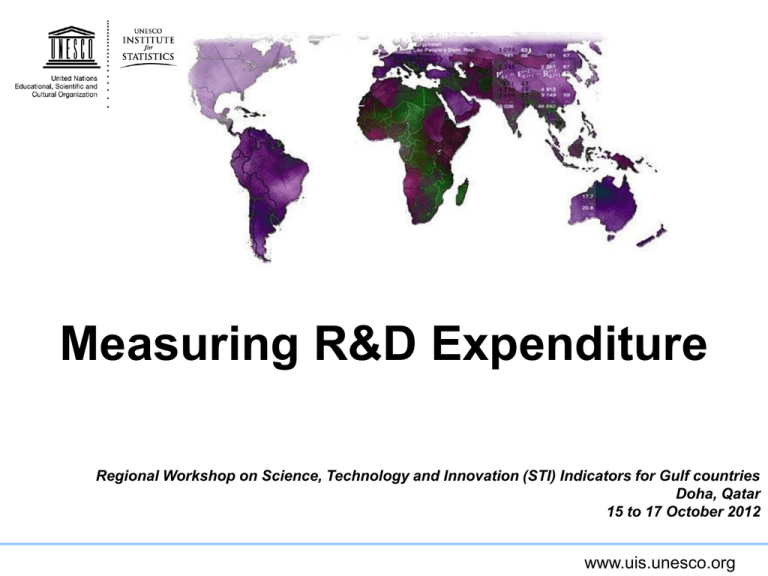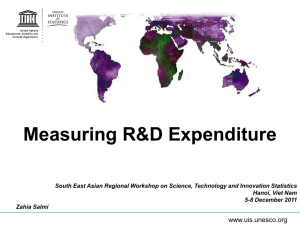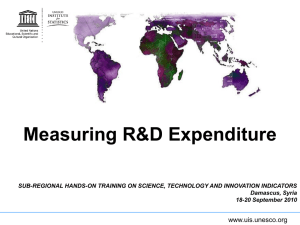R&D expenditure
advertisement

Measuring R&D Expenditure Regional Workshop on Science, Technology and Innovation (STI) Indicators for Gulf countries Doha, Qatar 15 to 17 October 2012 www.uis.unesco.org R&D expenditure - general issues Basic measure: “intramural expenditures” • All expenditures for R&D performed within a statistical unit or sector of the economy Another measure: “extramural expenditures” • covers payments for R&D performed outside the statistical unit or sector of the economy Current costs and capital expenditures are measured www.uis.unesco.org R&D expenditure: current costs Current costs are composed of labour costs and other current costs: • labour costs of R&D personnel » annual wages and salaries » all associated costs or fringe benefits » Share of R&D in total labour costs: could be estimated using R&D coefficients derived from timeuse studies; (could be applied at an appropriate level; individual, institute, department, university). www.uis.unesco.org R&D expenditure: current costs • other current costs » materials, supplies and equipment (incl. water, gas and electricity); » books, journals, reference materials, subscriptions; » materials for laboratories; » costs for on-site consultants; » administrative and other overhead costs; » costs for indirect services; » labour costs of non-R&D personnel. » Current costs may be prorated if necessary to allow for non-R&D activities within the same statistical unit. www.uis.unesco.org R&D expenditure: capital expenditure (1) Capital expenditures: annual gross expenditures on fixed assets used in the R&D programmes of statistical units • land and buildings • instruments and equipment • computer software www.uis.unesco.org R&D expenditure: capital expenditure (2): Pro rata expenditure Share of R&D in ‘Capital expenditure’ and ‘Other current costs’: could be estimated (by the institutes) on the basis of intended use; If intended use is not feasible as a criterion, the same distribution coefficients as for labour costs may be used. • Eg: consider a new laboratory that will be used for R&D (included), testing (excluded) and quality control (excluded). If the intended use of this new laboratory for R&D purposes maybe 40% of the total usage (ie. the other 60% for other activities), only 40% of the total construction cost of the building should be considered as the relevant R&D expenditure. www.uis.unesco.org R&D expenditure: capital expenditure (3) Expenditure should be reported in full for the period when it took place All depreciation provisions, whether real or imputed, should be excluded • Practical reasons • Government sector – no depreciation provisions; comparisons with other sectors • If depreciation is included in current costs, the addition of capital expenditures would result in double counting • Different accounting systems www.uis.unesco.org Measuring R&D expenditure (1) R&D involves significant transfers of resources among units, organisations and sectors • In particular between government and other performers • Important information for science policy R&D expenditure = resources actually spent on R&D activities, rather than only budgeted. For sound data rely on responses of R&D performers rather than funding agencies www.uis.unesco.org Measuring R&D expenditure (2) Issues when using secondary data from national budget • New sources of funds emerging (NGOs, Foreign entities, BE) • Discrepancy between voted and allocated budget • Budgetary commitments are not followed up • Mixing of budgetary records and annual reports from performing units • Definition of S&T / R&D budgets • Identifying R&D components in the national budget State-owned enterprises, university-owned companies and national scientific academies Public vs. Private universities Fiscal year vs. calendar year Information systems in government and higher education inadequate for statistics www.uis.unesco.org Measuring R&D expenditure (3) A statistical unit may have intramural and extramural expenditures on R&D The full procedure for measuring expenditures: • Identify intramural expenditure on R&D performed by each statistical unit • Identify the sources of funds as reported by the performer • Aggregate the data by sectors of performance and sources of funds to derive significant national totals • Optional: Identify the extramural R&D expenditures of each statistical unit www.uis.unesco.org Sources of R&D expenditure Criteria for identifying flows of R&D funds There must be a direct transfer of resources The transfer must be both intended and used for the performance of R&D www.uis.unesco.org Public general university funds (GUF) Universities draw on three types of funds to finance their R&D R&D contracts and earmarked grants from government and other outside sources credited to their original source Universities’ “own funds” • Income from endowments, shareholdings and property • fees from individual students • subscriptions to journals • sale of serum or agricultural produce General grant from the ministry of education (or corresponding authorities) in support of their overall research/teaching activities the R&D content of these public general university funds should be credited to government as a source of funds. www.uis.unesco.org GERD: Sector of performance and source of funds S o u r c e s Abroad: 200 200 (10%) (10%) 20 30 PNP: 250 (13%) 100 50 100 50 HE: 200 (10%) 50 GOV: 950 (48%) BE: 400 (20%) 50 20 100 50 30 50 300 500 100 50 P e r f o r m e r s PNP: 240 (12%) HE: 530 (27%) GOV: 800 (40%) 50 100 200 BE: 430 (22%) TOTAL GERD: 2000 GERD: Gross domestic expenditure on R&D www.uis.unesco.org GERD - matrix of performing and funding sectors Sectors of performance Funding sectors (Sources of funds) Business enterprise Government Higher education Private non-profit Total Business enterprise 200 100 50 50 400 - financed by BE Government 100 500 300 50 950 -financed by GOV Public general university funds (GUF) Included above financed by GUF Higher education 30 50 100 20 200 - financed by HE Private non-profit (PNP) 50 50 50 100 250 - financed by PNP Funds from Abroad • Foreign enterprise (Within group/Other) • Foreign govt. • EU • Intl. org. • Other 50 100 30 20 Total 200 - financed by abroad 430 Total performed by BE 800 Total performed by GOV 530 Total performed by HE 240 Total performed by PNP 2000 TOTAL GERD www.uis.unesco.org National totals Gross domestic expenditure on R&D (GERD): total intramural expenditure on R&D performed on the national territory during a given period. • includes R&D performed within a country (which financed by national institutions and also funded from abroad) but excludes payments for R&D performed abroad. • constructed by adding together the intramural expenditures of the four performing sectors. Gross national expenditure on R&D (GNERD): total expenditure on R&D financed by a country’s institutions during a given period. • includes R&D performed abroad but financed by national institutions or residents; it excludes R&D performed within a country but funded from abroad. • constructed by adding the domestically financed intramural expenditures of each performing sector and the R&D performed abroad but financed by domestic funding sectors www.uis.unesco.org Thank you! http://www.uis.unesco.org m.schaaper@unesco.org www.uis.unesco.org








